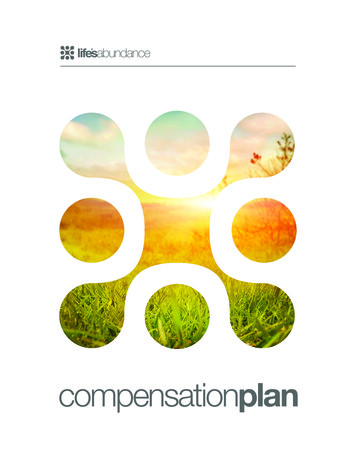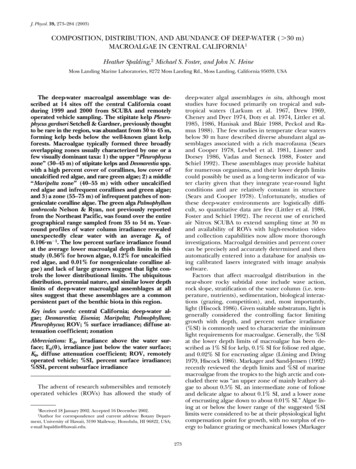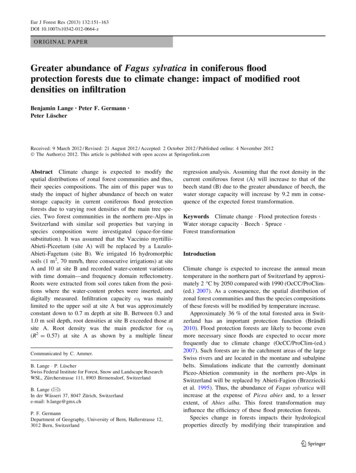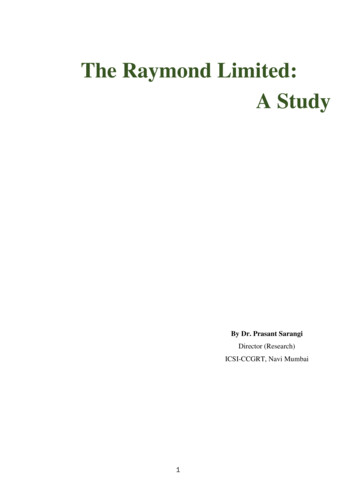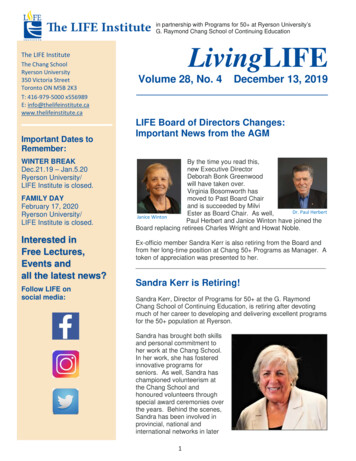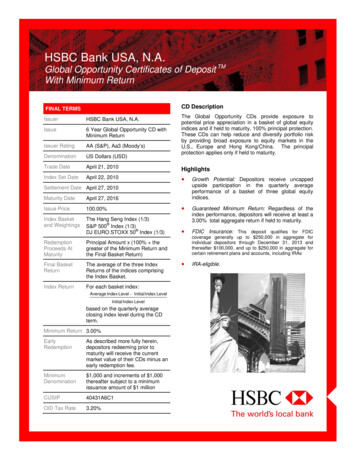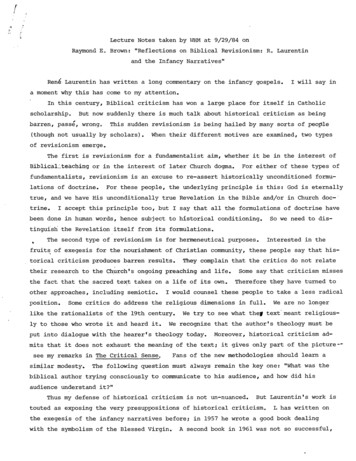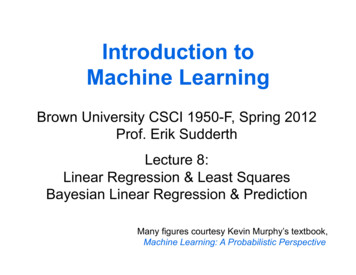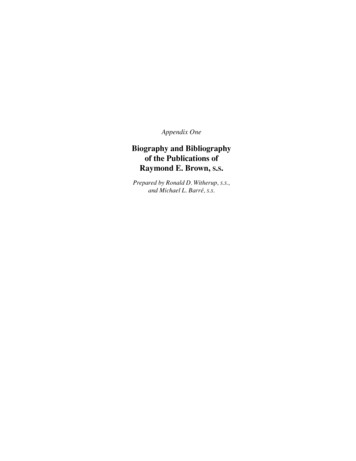
Transcription
Appendix OneBiography and Bibliographyof the Publications ofRaymond E. Brown, S.S.Prepared by Ronald D. Witherup, S.S.,and Michael L. Barré, S.S.
Biography of Raymond E. Brown, S.S.Ronald D. Witherup, S.S.The sudden death of renowned biblical scholar Raymond E. Brown at theage of seventy on August 8, 1998, deprived the church and the world of an eminent churchman and a premier exegete. The singular achievements of this remarkable person are unparalleled by any Catholic biblical scholar in thetwentieth century. As a prelude to the comprehensive bibliography of his publications, a brief biographical sketch is in order.Raymond Edward Brown was born on May 22, 1928 in the Bronx, NewYork City. He was the son of Reuben H. and Loretta (Sullivan) Brown, whoalso had one other son, Robert. Brown began his education in the Bronx, butin 1944 his family relocated to Miami Shores, Florida, where he completedhigh school. In 1945 he entered St. Charles College in Catonsville, Maryland,a college seminary program run by the Society of St. Sulpice, which is wherehe first encountered that community of priests he later joined (thus the initialsafter his name). The Sulpicians, as they are commonly called, are a community of diocesan priests founded in Paris in 1641, with the special ministry ofinitial and ongoing formation of Roman Catholic priests.Already a prodigious academic talent, Brown entered an accelerated program of studies and transferred to The Catholic University of America in1946, where he became a Basselin Scholar and obtained both a B.A. (1948)and M.A. (1949) in Philosophy. He then began advanced seminary studies atthe Gregorian University in Rome (1949–50), but at the request of his bishophe returned to the United States the following year to complete studies for thepriesthood at St. Mary’s Seminary and University in Baltimore, Maryland. St.Mary’s is the oldest Roman Catholic seminary in the United States, foundedby the Sulpicians in 1791 at the invitation of John Carroll, the first bishop ofthe United States. There Brown completed his theological training for priesthood, obtaining S.T.B. (1951) and S.T.L. (1953) degrees. He was ordained a254
Ronald D. Witherup, S.S.255priest on May 23, 1953 for the Diocese of St. Augustine (Florida) by ArchbishopJoseph Hurley, but he was immediately released to the Society of St. Sulpicesince he was attracted to biblical studies and the formation of future priests andhad become a candidate for the Sulpicians in 1951. He entered the Society formally in 1955 after completing the requirements for full membership.Many people have wondered how Brown became attracted to biblical studies, and fortunately he left a testimony of that process. While he was in Romeas a seminarian the Korean War broke out, and his bishop recalled him to theUnited States to enroll him in second theology at St. Mary’s. Given the rigidity of curricula in those days and the differences between the Roman and theAmerican systems of education, transferring was difficult. He was out of sequence and had missed some of the introductory Bible courses. A professortold him to study Old Testament on his own and he would then test him by anexamination. Brown’s own words describe what happened next:Well, he didn’t tell me how much to study, so I started reading the Old Testament and studying. I was fortunate enough to be able to read French and Italianand some German, so that actually I was reading better books than were available in English. And when I took the exam, he was highly complimentary. Hevirtually told me, “I didn’t mean you had to know that much.” He asked mewhether I was interested in the Bible. I said it was the most interesting thing Ihad ever done in my life; it was fascinating. (I had always wanted toteach. . . .) The professor said, “We do need teachers in Bible.”1When Brown’s bishop released him to the Sulpicians in 1953 he was assigned to teach at St. Charles Seminary in Catonsville, Maryland. This position also allowed him to complete a doctoral degree in theology at St. Mary’sSeminary (S.T.D., 1955) and to begin doctoral studies in Semitic languages atJohns Hopkins University. There he became a student of the world-renownedscholar William Foxwell Albright, known as “the dean of biblical archaeologists.” Brown finished his dissertation (Ph.D.) in 1958, a work that was todemonstrate his longstanding interest in combining Near Eastern and Old Testament studies with the study of the New Testament. As he once commented:“I always rejoice, by the way, that I taught Old Testament for six years. To me,it is wonderful to have taught the whole Bible.”2 Later, Brown also completeda Licentiate in Sacred Scripture from the Pontifical Biblical Institute in Rome(S.S.L., 1963), to round out his biblical education where he had obtained anearlier Baccalaureate in Sacred Scripture (S.S.B., 1959).At the end of his doctoral studies at Johns Hopkins, Brown was fortunate in1958–59 to be invited to work on the Dead Sea Scrolls in Jerusalem and Jordan,where he and fellow doctoral student and close friend Joseph A. Fitzmyer toileddiligently to create a preliminary concordance of those remarkable archaeological documents. Upon his return from Jerusalem the Sulpicians assigned Brownto teach at his alma mater, St. Mary’s Seminary and University in Baltimore.
256Biography of Raymond E. Brown, S.S.During those years, until 1971, he taught at St. Mary’s and continued to engagein scholarly research. He also worked on the commentary that was to thrust himinto the limelight of modern biblical scholarship, the two-volume Anchor Biblecommentary on the Gospel of John (A10 and A16 below).In 1971 Brown moved to New York, where he accepted a joint professorship at the Jesuit Woodstock College and Union Theological Seminary(1971–74). When Woodstock closed he accepted a full-time position at Union,where he taught for twenty years until his early retirement in 1990 as AuburnDistinguished Professor of Biblical Studies. Upon his “retirement,” which wasactually a cessation of teaching duties in order to be fully invested in researchand publication, Brown took up residence at the Sulpician-run St. Patrick’sSeminary in Menlo Park, California, at the invitation of then-Archbishop JohnR. Quinn. It was there that he died on August 8, 1998 of cardiac arrest, afterexperiencing difficulty breathing. His funeral liturgy was celebrated on August 17, 1998 at the same chapel in Catonsville, Maryland where he hadbegun his teaching career forty years earlier, and he was laid to rest at theSulpician cemetery on the grounds of the former seminary that now serves asCharlestown Retirement Community.A brief summary of major achievements provides an overview of his extensive career. From the publication of his dissertation in 1968 (finished in1958; digested as The Semitic Background of the Term “Mystery” in the NewTestament, A4 and A12 below) to the last book, which appeared five yearsafter his death, he published dozens of books, large and small, and hundredsof articles and major book reviews, which are assembled in the accompanyingbibliography.Brown also received many honors in his career, including more than thirtyhonorary doctorates. Among the more notable are honorary degrees fromAmerican and European universities like Edinburgh (1972), Uppsala (1974),DePaul (1974), Villanova (1975), Louvain (1976), Boston College (1977),Glasgow (1978), Fordham (1977), Hofstra (1985), Catholic University ofAmerica (1989), San Francisco (1994), Northwestern (1995), and CatholicTheological Union (1998). Among many other distinctions in the course of hiscareer, a few are worth highlighting. He served as a peritus (advisor) to hisbishop, Archbishop Hurley, during the first session of Vatican Council II(1962) and became the first Roman Catholic to address the Faith and OrderConference of the World Council of Churches in Montreal, Canada (1963). Hewas also the first person to serve as president of the three most prestigious societies for New Testament study, the Catholic Biblical Association (1971–72),the Society of Biblical Literature (1976–77), and the Society for the Study ofthe New Testament (1986–87).Brown was active in many church affairs and in several ecumenical ventures of importance. Pope Paul VI appointed him a consultant to the VaticanSecretariat for Christian Unity (1968–73), and he served as the only American
Ronald D. Witherup, S.S.257Catholic member of the Faith and Order Commission (1968–93). He also participated in the national dialogue between Roman Catholics and Lutherans(1965–74) and was a member of the special commission established by theWorld Council of Churches and the Roman Catholic Church to research thetopic of “Apostolicity and Catholicity” (1967–68).In an oft-quoted article, Time magazine named Brown “probably the premier Catholic Scripture scholar in the U.S.,” and the Catholic Theological Society of America named him “the outstanding American Catholic theologianof the year’ (1971). Pope Paul VI named Brown the only American member ofthe Pontifical Biblical Commission (1972–78), and he was honored again withmembership in that prestigious body when Pope John Paul II appointed him in1996, serving until his death. He was also inducted into Phi Beta Kappa, theAmerican Academy of Arts and Sciences, and the prestigious British Academy. Many of his publications won book awards, including the NationalCatholic Book Award for The Jerome Biblical Commentary (1969), Volume 2of The Gospel According to John (1971), and The Virginal Conception andBodily Resurrection of Jesus (1973); the National Religious Book Award forThe Birth of the Messiah (1977), and Mary in the New Testament (1978); theCatholic Press Association Book Award for Antioch and Rome (1984), and AnIntroduction to New Testament Christology (1994); and the Biblical Archaeological Society Award for The Churches the Apostles Left Behind (1986), andThe Death of the Messiah (1995).Although Brown spent the lion’s share of his scholarly career in only twoinstitutions, St. Mary’s Seminary and Union Theological Seminary, he heldmany visiting professorships, including positions at the Pontifical Biblical Institute (1973, 1988), the Albright School of Archaeology in Jerusalem (1978),and the North American College in Rome (1983, 1988). He also delivereddozens of lectures in prestigious series such as Thomas More (Yale, 1966,1987), Boylan (Dublin, 1971), W. H. Hoover (Chicago, 1975), Shaffer (Yale,1978), Cole (Vanderbilt, 1980), Bellarmine (St. Louis, 1980), Sprunt (UnionTheological in Richmond, 1980), Martin D’Arcy (Campion Hall, Oxford,1996), and T. W. Manson Memorial (Manchester, U.K., 1996).To his death Brown remained in demand as a popular lecturer. Some ofthose lectures are now available in audio cassettes, listed in the bibliography.Although a full assessment of his scholarly career remains to be done,Brown’s work has already been the topic of numerous dissertations and studies. Examples include: D. W. Wuerl, The Priesthood: The Doctrine of theThird Synod of Bishops and Recent Theological Conclusions (S.T.D. diss.;Rome: Angelicum, 1974); R. L. Hatchett, Towards a Post-critical Christological Hermeneutic: An Analysis of the Hermeneutics of Raymond E. Brown(Ph.D. diss.; Fort Worth, TX: Southwestern Baptist Theological Seminary,1989); K. Duffy, The Centrism of Raymond Brown: Historical Criticism inCatholic Christianity (Ph.D. diss.; University of London [Heythrop], 1990);
258Biography of Raymond E. Brown, S.S.and V. Costa, História e Fé na Comunidade Joanina segundo Raymond E.Brown (S.T.D. diss.; Rome: Gregorian, 1991).Although his scholarship was wide ranging, Brown’s most significant lasting contribution to biblical scholarship is doubtless in the area of Johanninestudies. He devoted his entire career to the Johannine literature, beginningwith the publication of his magisterial two-volume commentary on the Gospelof John (1966, 1970) and the subsequent publication of The Community of theBeloved Disciple (1979) and The Epistles of John (1983). His last publication,An Introduction to the Gospel of John (2003), had been intended to be the introduction to a major revision of his famous Anchor Bible commentary, but hedid not live to see the project fulfilled. Nonetheless, it remains a valuable contribution to the field and provides a final statement of Brown’s position on theFourth Gospel and how his thought had grown over the years.Among Brown’s other major works were two encyclopedic commentarieson the Infancy Narratives of the Gospels (The Birth of the Messiah, 1977, rev.ed. 1993) and on the Passion Narratives (The Death of the Messiah, 2 vols.,1994), and a widely respected Introduction to the New Testament (1997).The bibliography that follows is divided into four sections: A, Books andMonographs; B, Articles; C, Reviews; and D, Audio Tapes. Since many of thearticles have been gathered into books, the bibliography is completely crossindexed by section and entry number. Many of Brown’s books, large andsmall, have been translated into multiple languages, most recently Chinese,Russian, and Czech. Since more translations will be appearing in the yearsahead, this bibliography should be considered a “work in progress.”Notes1. Transcript of oral interview for “Oral History of the Catholic Biblical Association,” conducted by John Endres (December 3, 1996) 1; Sulpician Archives, Baltimore, MD.2. Transcript of “Oral History of the Catholic Biblical Association,” 15.
A Bibliography of the Publicationsof Raymond E. Brown, s.s.*Prepared by Michael L. Barré, S.S.A. Books and Monographs1949(1) “A Scholastic Investigation of the Space-Time Continuum of Relativity” (M.A.[Philosophy] Diss.; The Catholic University of America, 1949), ii 69 pp.1953(2) “The Sensus Plenior of Sacred Scripture” (S.T.L. Diss.; St. Mary’s Seminary and& University, 1953), ii 90 pp.1955(3) The Sensus Plenior of Sacred Scripture (S.T.D. Diss.; St. Mary’s Seminary and &University, 1955 [printed by Furst]), xiv 161. Reprinted by photo-offset (Ann Arbor,MI: Edwards, ca. 1960).1958(4) “The Semitic Background of the Pauline Myst rion”” (Ph.D. Diss.; The JohnsHopkins University, 1958), iii 243 pp. Digested in ##A12, B11, 12.1960(5) The Gospel of John and the Johannine Epistles. New Testament Reading Guide 13(Collegeville: Liturgical Press, 1960), 128 pp. Revised 2d ed., 1965. Further revised 3ded., 1982. Replaced in 1988 by #A33. Translations: Spanish: Evangelio y Epistolas deS. Juan (Santander: Sal Terrae, 1966).* Abbreviations for journals, series, and major reference works follow those listed in PatrickH. Alexander et al., eds., The SBL Handbook of Style: For Ancient Near Eastern, Biblical, andEarly Christian Studies (Peabody, MA: Hendrickson, 1999) 89–121. These abbreviations areused in The Catholic Biblical Quarterly and The Journal of Biblical Literature.259
260A Bibliography of the Publications of Raymond E. Brown, s.s.1962(6) The Book of Daniel. Pamphlet Bible Series 34 (New York: Paulist, 1962), 80 pp.1963(7) The Parables of the Gospels. Doctrinal Pamphlet Series (New York: Paulist, 1963),31 pp.1965(8) New Testament Essays (Milwaukee: Bruce, 1965), xvi 280 pp. British ed. (London: Chapman, 1966). Reprinted with new pagination and some revision (Garden City,NY: Doubleday, 1968). Reprinted by photo-offset from the Bruce edition with minorrevisions (New York: Paulist, 1982).(9) The Book of Deuteronomy. Old Testament Reading Guide 10 (Collegeville: Liturgical Press, 1965), 126 pp.1966(10) The Gospel According to John (i-xii). AB 29 (Garden City, NY: Doubleday,1966), cxlvi 538 pp. For vol. 2, see #A16. Section of the Introduction reprinted in H.K. McArthur, ed., In Search of the Historical Jesus (New York: Scribners, 1969)103–107. British ed. 2 vols. (London: Chapman, 1971). Translations: Italian: Giovanni: Commento al Vangelo spirituale. 2 vols. (Assisi: Cittadella, 1979); Spanish: ElEvangelio según Juan. 2 vols. (Madrid: Cristiandad, 1979; 2d ed. 2000).1967(11) Jesus God and Man: Modern Biblical Reflections (Milwaukee: Bruce, 1967), xiv 109 pp. Reproduces ##B46 and 61 (enlarged). Reprinted in paperback (New York:Macmillan, 1972). British ed. (London: Chapman, 1967). Translations: Dutch: JesusGod en Mens, with foreword by Piet Schoonenberg (Antwerp: Patmos, 1970); Italian:Gesù Dio e Uomo (Assisi: Cittadella, 1970); Spanish: Jesus, Dios y Hombre (Santander: Sal Terrae, 1973).1968(12) The Semitic Background of the Term “Mystery” in the New Testament. FBBS 21(Philadelphia: Fortress, 1968), vii 72 pp. Reprints ##B12 and 11, which are abridgements of #A4.(13) The Jerome Biblical Commentary (JBC), ed. Raymond E. Brown, Joseph A.Fitzmyer, and Roland E. Murphy. 2 vols. in one (Englewood Cliffs, NJ: Prentice-Hall,1968), xxxvi 637 835 pp. Brown edited the General Articles (nos. 40, 41, 46, 47,and 66 through 80). See #A35. British ed. (London: Chapman, 1969). Translations:Spanish: Comentario Bíblico “San Jeronimo.” 5 vols. (Madrid: Cristiandad, 1971–72);Italian: Grande Commentario Biblico Queriniana (Brescia: Queriniana, 1973).
Prepared by Michael L. Barré, S.S.261(14) Exégèse et Théologie: Les Saintes Écritures et leur interprétation théologique:Donum natalicium Iosepho Coppens septuagesimum annum complenti D.D.D. collegaeet amici, ed. Gustave Thils and Raymond E. Brown. BETL 26 (Gembloux: Duculot,1968), x 327 pp. From the 17th Journées Bibliques of Louvain, September 1966. Pp.72–81 reprint #B64.1969(15) Biblical Tendencies Today: An Introduction to the Post-Bultmannians, with P. J.Cahill (Washington: Corpus, 1969), vii 72 pp. Pp. 1–39 reprint (with editing) #B36.1970(16) The Gospel According to John (xiii-xxi). AB 29A (Garden City, NY: Doubleday,1970), xvi 539–1208. For British ed. and translations, see #A10.(17) Priest and Bishop: Biblical Reflections (New York: Paulist, 1970), 86 pp. Thefirst section was reprinted in various papers and popular magazines for priests. Reprint,Eugene, OR: Wipf & Stock, 1998. Translations: Italian: Il Prete e il Vescovo: Riflessioni bibliche (Fossano: Esperienze, 1971); Portuguese: Sacerdote e Bispo: ReflexõesBíblicas (São Paulo: Loyola, l987).1973(18) The Virginal Conception and Bodily Resurrection of Jesus (New York: Paulist,1973), viii 136 pp. Reprints #B82. British ed. (London: Chapman, 1973). Translations: Dutch: Jezus de Christus: Geboren uit een vrouw, Opgestaan uit de dood (Boxtel: Katholieke Bijbelstichting, 1975); Italian: La concezione verginale et larisurrezione corporea di Gesù. Giornale di Teologia 99 (Brescia: Queriniana, 1977; 2ded. [reprint], 1992); Portuguese: A Concepção Virginal e A Ressurreição Corporal deJesus (São Paulo: Loyola, 1987).(19) Peter in the New Testament: A Collaborative Assessment by Protestant andRoman Catholic Scholars, ed. Raymond E. Brown, Karl P. Donfried, and JohnReumann (New York: Paulist, 1973), x 181 pp. British ed. (London: Chapman,1974). Translations: French: Saint Pierre dans le Nouveau Testament. LD 79 (Paris:Cerf, 1974); German: Der Petrus der Bibel: Eine ökumenische Untersuchung(Stuttgart: Calwer Verlag and/Katholisches Bibelwerk, 1976); Spanish: Pedro en elNuevo Testamento. Palabra Inspirada 15 (Santander: Sal Terrae, 1976); Dutch: Petrusin het Geloof van de jonge Kerk (Boxtel: Katholieke Bijbelstichting, 1976); Japanese(Seibunsha, 1977); Italian: Pietro nel Nuovo Testamento (Rome: Borla, 1988).1975(20) Biblical Reflections on Crises Facing the Church (New York: Paulist, 1975), x 118 pp. British ed. (London: Darton, Longman & Todd, 1976). Translations: Dutch:Kerk waarheen nu? Bijbelse kanttekeningen bij hedendaagse crises en de Kerk (Boxtel: Kathlieke Bijbelstichting, 1976); Portuguese: Crises na Igreja? Reflexões Bíblicas(São Paulo: Loyola, 1987).
262A Bibliography of the Publications of Raymond E. Brown, s.s.1977(21) The Birth of the Messiah (Garden City, NY: Doubleday, 1977), 594 pp. See#A39. British ed. (London: Chapman, 1978). Translations: Italian: La nascità del Messia secondo Matteo e Luca (Assisi: Cittadella, 1981); Spanish: El nacimiento delMesías (Madrid: Cristiandad, 1982).1978(22) Mary in the New Testament: A Collaborative Assessment by Protestant andRoman Catholic Scholars, ed. Raymond E. Brown, Karl P. Donfried, Joseph A.Fitzmyer, and John Reumann (New York: Paulist, 1978), xii 323 pp. British ed. (London: Chapman, 1979). Translations: German: Maria im Neuen Testament: Eine ökumenische Untersuchung (Stuttgart: Katholisches Bibelwerk, 1981); Spanish: María enel Nuevo Testamento (Salamanca: Sigueme, 1982); Italian: Maria nel Nuovo Testamento (Assisi: Cittadella, 1985).(23) An Adult Christ at Christmas: Essays on the Three Biblical Christmas Stories—Matt 2 and Luke 2 (Collegeville: Liturgical Press, 1978), viii 50 pp. Unifies ##B99,105, 106, 108. Translations: Spanish: in article form in Biblia y Vida (Yucatan) 44 (December 1980) 25–31; 45 (January 1981) 10–14; 46 (February 1981) 7–14; 56 (December 1981) 21–28; unofficial publication: Universidad Iberoamericana, 1990; officialpublication: Un Cristo adulto en Navidad (Buenos Aires: San Pablo, 1994); Italian:Racconti biblici natalizi. Meditazioni 79 (Brescia: Queriniana, 1988; 2d ed. [reprint],1992); Portuguese: Um Cristo Adulto no Natal (São Paulo: Loyola, 1990); Chinese(Hong Kong: Catholic Truth Society, 1994); Catalan: Un Crist adult per Nadal(Barcelona: Claret, 1994); Korean (Seoul: St. Paul’s, 1995); Japanese (Tokyo: JoshiPauro-Kai [Paoline], 1996); German: Der Messias in der Krippe: Versuche über diedrei biblischen Weihnachtsgeschichten (Würzburg: Echter Verlag, 1997).1979(24) The Community of the Beloved Disciple (New York: Paulist, 1979), 204 pp.British ed. (London: Chapman, 1979). Philippine ed. (Manila: St Paul’s, 1996). Translations: German (abridged): Ringen um die Gemeinde (Salzburg: Müller, 1982); Italian: La comunità del discepolo prediletto (Assisi: Cittadella, 1982); Spanish: Lacomunidad del discípulo amado (Salamanca: Sigueme, 1983; 2d ed., 1987; 3d ed.,1991; 4th ed., 1996); French: La communauté du disciple bien-aimé. LD 115; (Paris:Cerf, 1983; reprint 2002); Portuguese: A comunidade do Discípulo Amado. NovaColeção Bíblica 17 (São Paulo: Paulus, 1984; 2d ed. 1992; 4th ed. 1999).1981(25) The Critical Meaning of the Bible (New York: Paulist, 1981), x 150 pp. Adaptsand reuses ##B103, 111, 116, 119, 123, 124, 125. British ed. (London: Chapman,1982). Translations: Portuguese: O Significado Crítico da Bíblia (São Paulo: Loyola,1987); Korean of Chapter Six (“An Example: Rethinking the Priesthood Biblically forAll,” pp. 96–106): Mee Joo Catholic Digest 11-12 (November/December 1991)(reprinted in Lumen Gentium [1993], 57–71); French: Croire en la Bible à l’Heure del’Exégèse (Paris: Cerf, 2002).
Prepared by Michael L. Barré, S.S.2631982(26) The Epistles of John. AB 30 (Garden City, NY: Doubleday, 1982), xxvii 812 pp.British ed. (London: Chapman, 1983). Translations: Italian: Le Lettere di Giovanni(Assisi: Cittadella, 1986).1983(27) Antioch and Rome: New Testament Cradles of Catholic Christianity, with John P.Meier (New York: Paulist, 1983), xii 242 pp. British ed. (London: Chapman, 1983).Translations: Italian: Antiochia e Roma (Assisi: Cittadella, 1987); French: Antioche etRome: Berceaux du christianisme. LD 131 (Paris: Cerf, 1988).(28) Recent Discoveries and the Biblical World (Wilmington: Michael Glazier, 1983).Reprint, Eugene, OR: Wipf & Stock, 2003), 101 pp. Revision of #B129. 2d (corrected)printing, 1985. Philippine ed. (Manila: St. Paul’s, 1994). Translations: Portuguese: Asrecentes descobertas e o mundo bíblico (São Paulo: Loyola, 1986).1984(29) The Churches the Apostles Left Behind (New York: Paulist, 1984), 156 pp. TheSprunt Lectures of January 1980 (Union Theological Seminary, Richmond). Chapter 8abridged in God’s Word Today 7 (January 1985): 40–45. British ed. (London: Chapman, 1984). Philippine ed. (Manila: St. Paul’s, 1994). Translations: Portuguese: AsIgrejas dos Apóstolos (São Paulo: Paulinas, 1986); French: L’Église héritée desapôtres. Lire la Bible 76 (Paris: Cerf, 1987); Italian: Le Chiese degli Apostoli:Indagine esegetica sulle origini dell’ecclesiologia (Casale Monferrato: Piemme,1992); Dutch: Kerkvormen in het spoor van de apostelen (’s-Hertogensbosch:Katholieke Bijbelstichting, 1993); Indonesian (Jakarta: Penerbit Kanisius, 1997);Japanese (Yotsuya Tokyo: Don Bosco [Salesian], 1998).1985(30) Biblical Exegesis and Church Doctrine (New York: Paulist, 1985), 171 pp.Adapts and reuses ##B126, 128, 130, 131, 132, 140, 143, 145, 146. British ed. (London: Chapman, 1985). Reprint Eugene, OR: Wipf & Stock, 2002.1986(31) A Crucified Christ in Holy Week: Essays on the Four Gospel Passion Narratives(Collegeville: Liturgical Press, 1986), 71 pp. Reuses ##B96, 137, 138, 142, 148.Translations: Italian: La Passione nei Vangeli. Meditazioni 72 (Brescia: Queriniana,1988); Spanish: Cristo Crucificado (Mexico City: Universidad Iberoamericana, 1989);Chinese (Hong Kong: Catholic Truth Society, 1992); Catalan: Un Crist crucificat en laSetmana Santa (Barcelona: Claret, 1994); Un Cristo Crucificado en Semana Santa(Buenos Aires: San Pablo, 1995); Portuguese: Um Cristo crucificado na Semana Santa(São Paulo: Ave Maria, 1996); Japanese (Tokyo: Joshi-Pauro-Kai [Paoline], 1997).(32) A Wise and Discerning Heart: Studies Presented to Joseph A. Fitzmyer, S.J. inCelebration of His 65th Birthday, ed. Raymond E. Brown and Alexander A. Di Lella(Washington: Catholic Biblical Association, 1986) CBQ 48/3 (July 1986).
264A Bibliography of the Publications of Raymond E. Brown, s.s.1988(33) The Gospel and Epistles of John: A Concise Commentary (Collegeville: Liturgical Press, 1988), 136 pp. A major rewriting of #A5, using the Revised NAB as basictext. Indian ed. (Bombay: St. Paul, 1993). Philippine ed. (Manila: St. Paul’s, 1994).Translations: Italian: Il Vangelo e le Lettere di Giovanni. Biblioteca Biblica 14 (Brescia: Queriniana, 1994).(34) A Coming Christ in Advent: Essays on the Gospel Narratives Preparing for theBirth of Jesus—Matt 1 and Luke 1 (Collegeville: Liturgical Press, 1988), 71 pp. Unifies##B151, 152, 155, 158, 159. Translations: Italian: Avvento: il Cristo che viene. Meditazioni 83 (Brescia: Queriniana, 1989); Chinese (Hong Kong: Catholic Truth Society,1994); Spanish: Cristo llega en Adviento (Buenos Aires: San Pablo, 1994); Catalan: UnCrist que ve (arriba) en l’Advent (Barcelona: Claret, 1994); Japanese (Tokyo: JoshiPauro-Kai [Paoline], 1996); German: Der kommende Christus: Eine Auslegung derEvangelien im Advent (Würzburg: Echter Verlag, 1997); Slovak: Kristus v Advent(Trnava: Dobrá kniha, 2000).1989(35) The New Jerome Biblical Commentary (NJBC), ed. Raymond E. Brown, JosephA. Fitzmyer, and Roland E. Murphy (Englewood Cliffs, NJ: Prentice-Hall, 1990),xlviii 1475. Brown edited the General Articles (40, 45, 65-83). For the JBC (1968)see #A13. British ed. (London: Chapman, 1990). Indian ed. (Bangalore: TheologicalPublications, 1990). Student (paperback) ed. (London: Chapman, 1993). Translations:Italian: Nuovo Grande Commentario Biblico (Brescia: Queriniana, 1997).1990(36) Responses to 101 Questions on the Bible (New York: Paulist, 1990), 147 pp.British ed. (London: Chapman, 1990). Indian ed. (Bombay: St. Paul, 1991; 2d ed.1993). Philippine ed. (Quezon City: Claretian, 1993). Translations: Italian: Risposte a101 domande sulla Bibbia (Brescia: Queriniana, 1991); French: 101 Questions sur laBible. Lire la Bible 98 (Paris: Cerf, 1993); Chinese (Hong Kong: Catholic Truth Society, 1993; 2d ed., 2001); Portuguese: 101 perguntas sobre a Bíblia (Lisbon: Circulode Leitores, 1994); Malayalam (Kerala) (Ernakulam: St. Paul’s, 1994); Japanese(Tokyo: Joshi-Pauro-Kai, 1995); Spanish: 101 preguntas y respuestas sobre la Biblia.Nueva alianza 138 (Salamanca: Sigueme, 1996; 2d printing, 1997); Slovak: Biblia 101otázok a odpovedí (Trnava: Dobrá kniha, 1999).1991(37) A Risen Christ in Eastertime: Essays on the Gospel Narratives of the Resurrection (Collegeville: Liturgical Press, 1991), 95 pp. Unifies ##B176, 179, 181. Translations: Italian: I racconti evangelici della Risurrezione. Meditazioni 100 (Brescia:Queriniana, 1992); Catalan: Un Crist ressuscitat en temps de Pasqua (Barcelona:Claret, 1994); Chinese (Hong Kong: Catholic Truth Society, 1994); Spanish: Un CristoResuscitado en Tiempo Pascual (Buenos Aires: San Pablo, 1995); Korean (Seoul: StPaul’s, 1996); Portuguese: Um Cristo Ressuscitado na Páscoa (São Paulo, Brazil: AveMaria, 1996); Japanese (Tokyo: Joshi-Pauro-Kai [Paoline], 1997).
Prepared by Michael L. Barré, S.S.2651992(38) The New Jerome Bible Handbook, ed. Raymond E. Brown, Joseph A. Fitzmyer,and Roland E. Murphy (London: Chapman, 1992), 456 pp. American ed. (Collegeville:Liturgical Press, 1992).1993(39) The Birth of the Messiah: New Updated Edition. ABRL (New York: Doubleday,1993), 752 pp. See #A21. British ed. (London: Chapman, 1993). Translations: Italian:La nascità del Messia secondo Matteo e Luca (Assisi: Cittadella, 2002).1994(40) The Death of the Messiah: From Gethsemane to the Grave: A Commentary on thePassion Narratives of the Four Gospels. 2 vols. ABRL (New York: Doubleday, 1994),xxvii 1608 pp. British ed. (London: Chapman, 1994). Translations: Italian: La Mortedel Messia: dal Getsemani al sepolcro, un commentario ai raconti della passione neiquattro vangeli. BTC 108 (Brescia: Queriniana, 1999).(41) A Once-and-Coming Spirit at Pentecost: Essays on the Liturgical Readings between Easter and Pentecost, Taken from the Acts of the Apostles and from the Gospelaccording to John (Collegeville: Liturgical Press, 1994), iii 98 pp. Translations:Catalan: Un esperit que ha vingut i que ve en la Pentecosta (Barcelona: Claret, 1994);Italian: Azione e promessa dello Spirito a Pentecoste. Meditazioni 114 (Brescia:Queriniana, 1995); Spanish: El Espíritu que viene en Pentecostés (Buenos Aires: SanPablo, 1995); Japanese (Tokyo: Joshi-Pauro-Kai [Paolin
Raymond Edward Brown was born on May 22, 1928 in the Bronx, New York City. He was the son of Reuben H. and Loretta (Sullivan) Brown, who also had one other son, Robert. Brown began his education in the Bronx, but in 1944 his family relocated
